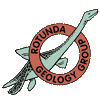Summer Field Programme - 8 June 2013
Rosedale – Geology and Industrial Archaeology (joint meeting with Scarborough Archaeological and Historical Society)
Chris Hall with Peter Rawson & Steve Livera
Meet at 10:30 am at the car park at the top of Rosedale Chimney Bank (SE 7240 9478)
There is a toilet block in Rosedale Abbey, but no toilet or refreshment facilities on the sites to be visited. A packed lunch is needed but there are shops in Rosedale Abbey. The relevant maps are OS 1:25,000 OL26 (south) BGS 1:50,000 43 (Egton). It would be useful to bring a pair of binoculars. Helmets are not needed. Expect some rough terrain with some steep ascents and descents – strong footwear is needed. There are trip hazards due to uneven ground, landslips, extensive burrowing by rabbits in places and partially buried remains. Part of the former tramway between the Stone Kilns and Iron Kilns, Rosedale East side is built on a ledge which has a steep drop. Safety notices around ruinous structures such as the kilns must be adhered to. The field excursion is in two parts
Rosedale West. We commence by walking along the old track to the top of the calcining kilns and looking at the site of the inclined tramway by which the ironstone was brought up from the mines. A short walk takes us to the site of the engine shed, workers cottages etc. Views across the valley give us the context of the East Mines and the geological overview, highlighting the Lower to Middle Jurassic transition as it is reflected in the topography. Return passing below the calcining kilns to the incline to look down onto the workings for the Garbutts and Kitchings deposits (magnetic ironstone). The total distance is 1.8 km (about 1 mile) with an ascent/descent of about 20 metres (65’) taking 1.5 to 2 hours.
Car share to transfer across to Hill Cottages (there is limited parking there so car sharing is essential). Lunch stop.
Rosedale East. From Hill Row we look at the site of the railway depot, coal bunkers and goods shed. The stratigraphic positioning of the Mines will be defined by first visiting an exposure of the Lower Jurassic, Yeovilian, Low Baring Member with its distinctive bioturbation skolithos. We then take the tramway route which passes close to the top of the Stone Kilns past a ventilator stack and two of the entrances to the East Mines. Adjacent to an adit marked by an arch is an exposure of the Dogger Formation black shales overlain by laterally extensive sandstones. A little further north a contrasting Saltwick Formation channel overlies the Dogger and marks the complete change from shallow marine to ‘deltaic’ palaeoenvironments. The tramway then continues past a further drift entrance, the remains of an engine base and past the top of the Iron Kilns to the ruins of some workshops and the row of cottages at High Baring. From here we take the higher level of the standard gauge railway past an exposure of the Dogger Formation. The total distance is 4.4 km (just under 3 miles) with an ascent/descent of about 15 metres (50’) taking 2 hours plus (depends on the weather)
